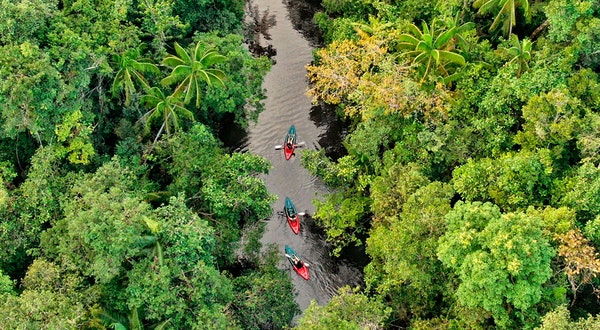Rewilding—the reintroduction of native wildlife—is vital within the combat towards local weather change. Right here, six vital initiatives from Argentina to the Maldives.
For 10 years now, one ebook has held a spot in my ever-changing pile of bedside studying: Caroline Fraser’s Rewilding the World: Dispatches from the Conservation Revolution (Metropolitan Books, 2010). After I first purchased the ebook, the time period “rewilding” instructed to me the restoration of an Edenic wilderness. However, as I realized, rewilding is a gradual course of, involving the reintroduction of native wildlife, in order that nature can take its course with minimal human intervention.
Previously half century, the world has misplaced two-thirds of its wetlands, grasslands, and wildlife—and within the final 5 years alone, the planet has misplaced roughly 125 million acres of forests. Rewilding seeks to treatment that. It seems totally different relying upon the placement, and probably the most profitable initiatives think about each geographical and area people wants that come up when “giving the land again to wildlife, and wildlife again to the land,” as John Davis, govt director of the Rewilding Institute, put it.
The objectives differ from mission to mission: For some, the purpose of rewilding is to create pure areas for people to get pleasure from; for others, it’s to reintroduce mammals which are vital to habitat rehabilitation. Yellowstone Nationwide Park, for instance, successfully reintroduced wolves in 1995.
Wolves are native to Wyoming, however by 1926 that they had been eradicated by searching. Over the a long time, the elk and deer inhabitants exploded. That led to overgrazing, which decimated new tree progress, jeopardizing the chicken and beaver populations, each essential to that ecosystem’s survival. Conservationists reintroduced the wolves (introduced from Canada), and while you go to Yellowstone right now, you’ll discover a lush number of habitats and wildlife.
There are different success tales too. In the course of the COVID-19 lockdowns, when journey and business had been all however halted, air, noise, and water air pollution cleared up—briefly. Animals explored past the boundaries they’d been given, and their survival charges improved. The “anthropause” made clear that nature can bounce again, even after struggling hurt brought on by people.
Whereas rewilding continues to face vital pushback—it takes cash, time, and political will, and it should dovetail with the agriculture wants of feeding the planet—it’s extra vital than ever. Listed here are among the most fascinating rewilding initiatives within the works—and methods vacationers might help inexperienced the world.
Experience by means of wetlands in Iberá Nationwide Park
Argentina
Based in 2018 by former Patagonia CEO Kris Tompkins, Iberá—a 395,000-acre park in northeast Argentina—is without doubt one of the world’s largest freshwater wetlands and grasslands rewilding initiatives, one the place big anteaters, collared peccaries (piglike mammals), and red-and-green macaws have returned. The Tompkins Conservation, which manages the park, has helped reintroduce such prime predators as jaguars and big otters.
Ecological restoration goes hand in hand with cultural restoration: Native guides lead kayaking excursions, canoe excursions with horses pulling the boats by means of shallow waters, and in a single day horseback journeys by means of the wetlands which are primarily based on criollo custom and rooted within the guides’ Spanish and Guaraní heritage.
Key mission: Reintroducing the jaguar
Within the Fifties, searching and habitat loss drove jaguars to native extinction within the Iberá wetlands. Seventy years later, in 2021, Rewilding Argentina launched seven jaguars, who now roam the park. Conservationists hope that they are going to repopulate the world.
Patrol wildlife in Botom Sakor Nationwide Park
Cambodia
Because the Nineties, unlawful logging and poaching have ravaged the jungle of this 423,168-acre park. However Cardamom Tented Camp (CTC) on the park’s heart—accessible solely by boat—offers a secure hall into the Cardamom Mountains for wildlife, in addition to a solar-powered, luxurious glamping web site for vacationers.
Two NGOs—Wildlife Alliance and the Golden Triangle Asian Elephant Foundation—partnered to create the hall, working with native rangers (who shield the forest by confiscating snares and confronting poachers) to make it a haven for such animals as Asian elephants, clouded leopards, and inexperienced peafowl.
Company can take ranger-guided treks by means of evergreen forests and kayak alongside the Preak Tachan River, probably recognizing gibbons, otters, and plentiful birdlife alongside the best way. For the intrepid, an in a single day patrol with rangers consists of studying survival abilities, monitoring wildlife, and sleeping in a tent beneath the celebs.
Key mission: Park ranger patrols
Cambodia has one of many highest charges of deforestation on the earth, and wildlife trafficking is a profitable enterprise, which makes guarding the jungle tough. Twelve rangers, a few of whom are former poachers, patrol the 44,470-acre portion CTC oversees. Patrols can generally final every week—through the wet season roads and trails get washed out—and confronting poachers may be harmful.
Proof of the rangers’ success is the tranquility of the camp, in addition to the 1000’s of confiscated snares on show on the ranger station. Within the final 5 years, they’ve rid the world of practically 99 % of poachers and loggers.

Plant bushes in Gorongosa Nationwide Park
Mozambique
When Greg Carr, president of the Gorongosa Challenge in Gorongosa National Park, first drove by means of the park in 2004, he noticed “maybe one baboon or warthog.” A 15-year civil battle had decimated the world’s wildlife. At the moment, should you drive by means of the park—which incorporates roughly 1,500 sq. miles of mountainsides, plateau forests, escarpment canyons, palm savannas, and wetlands—you see wildebeests, elephants, lions, hippos, fish eagles, and baboons, amongst different species.
Gorongosa’s restoration concerned two phases of rewilding: Starting in 2006, the park reintroduced herbivores (buffalo, wildebeests, zebras, and extra) to assist the ecosystem get well by itself; in 2018, it started reintroducing such carnivores as cheetahs, adopted by the primary leopard in 2020.
Park guests can discover present rewilding analysis on the E.O. Wilson lab or be a part of park warden Pedro Muagura in planting native bushes. They’ll additionally study his Sena tradition and, to know the holistic course of required to guard the rain forest, go to the espresso plantation Muagura based.
Key mission: Launching a espresso farm
In 2011, Muagura planted the primary arabica espresso tree on Mount Gorongosa, offering an earnings whereas additionally restoring the forest. (Shade-grown espresso plantations present vital houses for native bugs and migratory birds.) At the moment, some 858 folks (350 are ladies) look after round 650,000 espresso bushes per yr, creating an income-producing different to tourism in case of, say, a worldwide pandemic.
Observe bison within the Southern Carpathian Mountains
Romania
These grand mountains—often known as the Transylvanian Alps—comprise a few of Europe’s final remaining old-growth forests, in addition to valleys, deep caves, and a wholesome inhabitants of bears, wolves, and lynx. But this ecosystem has been threatened by years of unlawful logging—and it’s been lacking a keystone species for at the very least 200 years: the European bison.
The European bison has been round for 1000’s of years: It’s been depicted in cave work, and its curved horns had been used as ornate cups within the Center Ages. Bison devour copious quantities of grasses, leaves, and bark every day, aerating the soil with their hooves and spreading seeds that get caught of their fur or excreted of their dung.
They create open glades within the woods, the place daylight can shine on the forest flooring, supporting flora and animal variety. They take sand baths, creating micro-habitats that profit crops and bugs, then birds and bats. Their carcasses, when left to decay naturally, are a meals supply for a lot of creatures.
Key mission: Reintroducing the European bison
Rewilding Europe and the World Wildlife Foundation, along with native communities, reintroduced bison in 2014, and right now some 100 of the animals roam free. With WeWilder, vacationers can monitor bison within the snow and have hearth chats with native guides in regards to the animals’ ecological significance.
Chook-watch within the Madrean Sky Islands
Mexico and america
Made up of 55 mountain “islands” surrounded by valley “seas” in northwestern Mexico and the southwestern United States, the Madrean Sky Islands represent probably the most biodiverse areas in North America. Many animals rely upon wildlife corridors to journey from one sky island to the following to seek out meals and to breed. Among the many native inhabitants are thick-billed parrots, leopard frogs, ocelots, and pygmy owls.
The Sky Island Alliance’s initiatives embody connecting wildlife corridors, defending vital water sources, and bettering habitats for iconic cats, similar to mountain lions and jaguars, the latter put in jeopardy by the U.S.-Mexico border wall, which obstructs their conventional migratory paths.
As a part of a citizen science program, vacationers might help survey springs, set up rock buildings to forestall erosion, take away invasive crops, study wilderness survival abilities, or take birding and nature treks.
Key mission: Defending sky islands
A sky island is a part of a forested mountain vary surrounded by a sea of desert and grasslands. Inside the practically 42-million-acre Madrean Sky Islands, mountain peaks of three,000 to greater than 10,000 toes host various habitats and microclimates that go well with every part from snails to parrots to spruce fir. Greater than 7,000 crops, animals, and bugs may be discovered right here, and practically half of all chicken species in North America go by means of sooner or later or different.
Seawild within the Laamu Atoll
The Maldives
This 24-mile-long archipelago is certainly one of greater than two dozen that comprise the Maldive archipelago. Its coral reefs home such critically endangered and threatened species as hammerhead sharks, manta rays, and hawksbill turtles. The island can be house to seagrass meadows, which act as carbon reservoirs, nurseries for fish life, and safety for low-lying atolls.
Olhuveli Island, one of many 82 islands within the Laamu Atoll, has been rewilding its sea, increasing seagrass meadows by 20 %. Via Six Senses Laamu, vacationers can take guided snorkeling excursions of the ocean meadows, be a part of the biology staff to tour coral reefs at evening and study coral spawning, and attend packages on the resort’s Earth Lab. Kids can take part within the junior marine biology program.
Key mission: Defending seagrass meadows
Often called the “lungs of the ocean,” seagrass meadows generate oxygen and seize carbon. Seagrass lives and grows completely underwater, and whereas usually confused with seaweed, is a vascular flowering plant.
The meadows are a habitat for a lot of marine creatures, from tiny snails to sharks and sting rays, lots of them a part of the coral reef ecosystem; the 2 habitats are carefully related. With a root system that binds collectively sediment, the meadows additionally stabilize seabeds, stopping island erosion. That is essential to the Maldives’ survival as temperatures—and sea ranges—rise.
>>Subsequent: Scotland Is Poised to Become the World’s First Rewilding Nation
Merchandise we write about are independently vetted and advisable by our editors. AFAR might earn a fee should you purchase by means of our hyperlinks, which helps assist our impartial publication.




Recent Comments